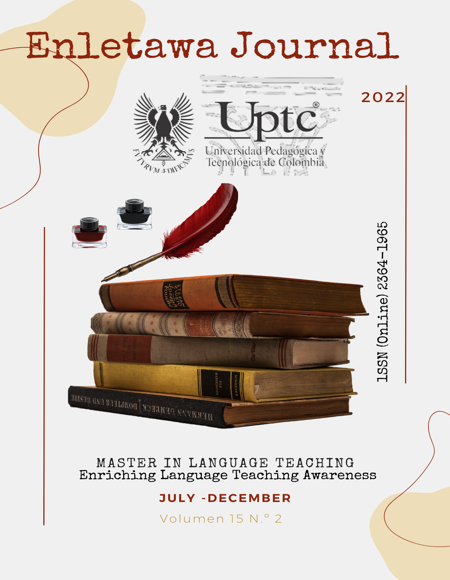Contributions of Printed Material in the Teaching of English as a Foreign Language During the Period of Distance Education in the Municipality of Saboyá

Abstract
This project focuses on a qualitative research method called intrinsic case study, which aims to explore and analyze the contributions of printed material in the teaching of English as a foreign language in four public and elementary schools in rural and urban areas of Saboyá, Boyacá. The project arose due to the changes that occurred in distance learning from June to November 2020. The instruments used to collect information were a survey, a structured interview, and the printed material designed by the teachers. The results of the research showed the decision-making process that the teachers carried out when preparing their classes, in which they included topics from other subjects. This methodology is known as Content and Language Integrated Learning (CLIL). In addition, the design of the printed material was suitable to achieve the objectives of the class and helped the students to improve their fine motor skills and English vocabulary
Keywords
printed materials, Enseñanza del Inglés como Lengua Extranjera (TEFL), distance education, distance learning and teachers’ perspectives
Author Biography
Juan Manuel Guerrero Beltran
Active Bachelor’s student in Bilingualism. Universidad El Bosque
Yenny Paola Flórez Delgado
Active Bachelor’s student in Bilingualism. Universidad El Bosque
Maria Fernanda Pérez Jimenez
Active Bachelor’s student in Bilingualism. Universidad El Bosque
Nicole Marie Perez Pereira
Active Bachelor’s student in Bilingualism. Universidad El Bosque
References
- Boudreau, E. (2020, July 1). What Makes an Excellent Online Teacher? Harvard Graduate School of Education. https://www.gse.harvard.edu/news/uk/20/07/what-makes-excellent-online-teacher
- Chen-Loyola. (2013). Print Materials for Effective Instruction. https://chenloyola.wordpress.com/eds-151-instructional-media-resources/print-materials-for-effective-instruction/
- Crowe, S., Cresswell, K., Robertson, A. et al. (2011). The Case Study Approach. BMC Medical Research Methodology, 11(100). https://bmcmedresmethodol.biomedcentral.com/articles/10.1186/1471-2288-11-100 DOI: https://doi.org/10.1186/1471-2288-11-100
- Darwish, S. (2014). Teachers’ Perceptions on Authentic Materials in Language Teaching in Kuwait. Journal of Education and Practice, 5(18). https://core.ac.uk/download/pdf/234635906.pdf
- Florida Center for Instructional Technology. (2009). A Teacher's Guide to Distance Learning. Chapter 6. print technologies. FCIT. https://fcit.usf.edu/distance/chap6.htm
- Formplus blog (2020). Structured Interviews: Definition, Types + [Question Examples]. Formpl. https://www.formpl.us/blog/structured-interview
- History Philippine Normal University -HPNU-. (2015, July 28). Printed Materials. Educational Technology. Non-Projected Media. https://edtechnonprojectedmedia.wordpress.com/2015/07/16/printed-materials/
- International TEFL and TESOL training (iTTT). (2011). TEFL/TESOL Guide to Teaching English Abroad. TEFL Course. https://www.teflcourse.net/pdf/guide.pdf
- Lawrence, J. (2016). Role of Instructional Materials in Academic Performance in Community Secondary Schools in Rombo District. University of Tanzania. https://core.ac.uk/download/pdf/83632862.pdf
- Logsdon, A. (2021). Fine Motor Skills for Toddlers and Preschoolers: What Are Fine Motor Skills? Very well family. https://www.verywellfamily.com/what-are-fine-motor-skills-2162037
- Macías, D. F. (2010). Considering New Perspectives in ELT in Colombia: From EFL to ELF. HOW Journal, 17(1), 181-194. https://howjournalcolombia.org/index.php/how/article/view/72
- McKay, L. S (2003). Teaching English as an International Language: Rethinking Goals and Perspectives. The Electronic Journal for English as a Second Language, 7(1). http://www.tesl-ej.org/wordpress/issues/volume7/ej25/ej25r5/
- Moore, S. (1997). The Role of the Teacher in Distance Education: The Teacher Perspective. Mount Royal College. https://files.eric.ed.gov/fulltext/ED407022.pdf
- Owiti, T., Barasa, P., & Omulando, C. (2019, February). Teachers’ Conceptualization of Authentic Printed Materials in the Teaching of Intensive Reading in Secondary Schools in Bondo Sub-County, Kenya. Journal of Education and Research, 7(2). https://www.researchgate.net/publication/346400616_Teachers'_Conceptualization_of_Authentic_Printed_Materials_in_the_Teaching_of_Intensive_Reading_in_Secondary_Schools_in_Bondo_Sub-County_Kenya
- Pol, F. (2017). An Analysis of Synchronous and Asynchronous Communication Tools in e-Learning. Advanced Science and Technology Letters, 143, 230-234. https://www.researchgate.net/publication/313673458_An_Analysis_of_Synchronous_and_Asynchronous_Communication_Tools_in_e-Learning
- Rodríguez, M. (2011, August). CLILL: Colombia Leading into Content Language Learning. Íkala Revista de Lenguaje y Cultura 16(28). http://www.scielo.org.co/scielo.php?script=sci_arttext&pid=S0123-34322011000200004 DOI: https://doi.org/10.17533/udea.ikala.9912
- Simonson, M., Zvacek, S., & Smaldino, S. (2019). Teaching and Learning at a Distance: Foundations of Distance Education (7th ed.) Information Age Publishing. https://books.google.com.co/books?hl=en&lr=&id=qh-3DwAAQBAJ&oi=fnd&pg=PR1&dq=distance+teaching+in+elementary&ots=EdxkFY6hEK&sig=MRzrShiFfxWIOsL1WrdR7Ls6_g#v=onepage&q=distance%20teaching%20in%20elementary&f=false
- Story, D. A., & Tait, A. R. (2019). Survey Research. Anesthesiology, 130(2), 192-202. https://doi.org/10.1097/ALN.0000000000002436 DOI: https://doi.org/10.1097/ALN.0000000000002436
- Usma, J. (2009). Education and Language Policy in Colombia: Exploring Processes of Inclusion, Exclusion, and Stratification in Times of Global Reform. Profile, 11, 123-141. https://www.researchgate.net/publication/237645132_Education_and_Language_Policy_in_Colombia_Exploring_Processes_of_Inclusion_Exclusion_and_Stratification_in_Times_of_Global_Reform_Politicas_educativas_y_linguisticas_en_Colombia_procesos_de_inclusion_
- Vélez-Rendón, G. (May 1, 2003). English in Colombia: A Sociolinguistic Profile. World Englishes, 22(2),185-198. https://doi.org/10.1111/1467-971X.00287 DOI: https://doi.org/10.1111/1467-971X.00287
- Wiseman, J. (July 23, 2018). What Is Content and Language Integrated Learning? Resources for English Language Learners and Teachers. Pearson English. https://www.english.com/blog/content-and-language-integrated-learning/#:%7E:text=Content%20and%20Language%20Integrated%20Learning%20(CLIL)%20is%20an%20approach%20where,relevant%20vocabulary%20and%20language%20skills.
- Yu, X. (2020). English Vocabulary Teaching Techniques at Junior Middle Schools. English Language Teaching, 13(11). https://doi.org/10.5539/elt.v13n11p12 DOI: https://doi.org/10.5539/elt.v13n11p12
